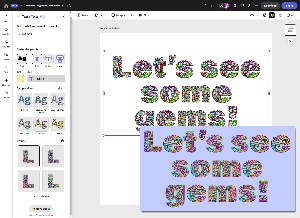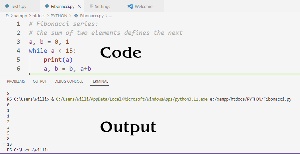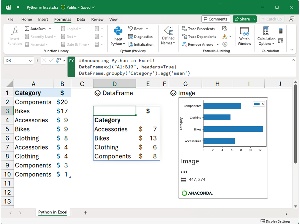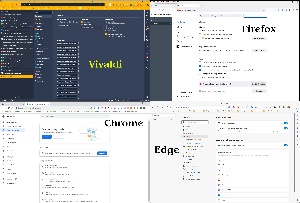Listen to the Podcast
8 Sep 2023 - Podcast #848 - (16:55)
It's Like NPR on the Web
If you find the information TechByter Worldwide provides useful or interesting, please consider a contribution.

If you find the information TechByter Worldwide provides useful or interesting, please consider a contribution.
You have access to Adobe Express if you’re a Creative Cloud subscriber, but it’s also available for free. Creative Cloud also includes Photoshop, Illustrator, and other creative tools, so what’s the point of Express? That’s clear after you’ve used if for a few minutes: Tasks that could be cumbersome and difficult become quick and easy.
Click any small image for a full-size view. To dismiss the larger image, press ESC or tap outside the image.
 I’m still recovering from a back injury and surgery, and part of that recovery involves learning to walk again. So when I made five circuits of the track at the community center, I wanted to let friends know, but I didn’t want to spend a lot of time on it. Express to the rescue. I looked through the various templates and found one that was intended as a Fourth of July greeting. In less than a minute, I changed “Happy” to “Five Laps”, changed “4th of July” to “2997 Steps”, and posted the image. It was a trifecta: Quick, Easy, and Fun.
I’m still recovering from a back injury and surgery, and part of that recovery involves learning to walk again. So when I made five circuits of the track at the community center, I wanted to let friends know, but I didn’t want to spend a lot of time on it. Express to the rescue. I looked through the various templates and found one that was intended as a Fourth of July greeting. In less than a minute, I changed “Happy” to “Five Laps”, changed “4th of July” to “2997 Steps”, and posted the image. It was a trifecta: Quick, Easy, and Fun.
Although Express is included in Creative Cloud and it can be licensed individually for $10 per month, there’s also a free version that requires only a free Adobe account. There are limitations, of course, but even the basics are pretty impressive. You have access to thousands of templates, a limited collection of royalty-free Adobe Stock photos, some Adobe Fonts, design assets, quick actions, and and other features. Free and paid versions both work on desktop and mobile systems and the free version even gets 5GB of online storage.
 The $10/month plan includes all premium templates and design assets along with more than 20,000 licensed Adobe Fonts, curved type, grids, and font pairs. You can also use more than 160 million royalty-free Adobe Stock collection photos and premium features such as refine cutout, resize, and graphic groups are added. In addition to 100GB of storage, the paid version can create PDF files, has access to Creative Cloud Libraries, and allows users to add their own branding, logo, colors, and fonts.
The $10/month plan includes all premium templates and design assets along with more than 20,000 licensed Adobe Fonts, curved type, grids, and font pairs. You can also use more than 160 million royalty-free Adobe Stock collection photos and premium features such as refine cutout, resize, and graphic groups are added. In addition to 100GB of storage, the paid version can create PDF files, has access to Creative Cloud Libraries, and allows users to add their own branding, logo, colors, and fonts.
The premium plan includes several other apps: Premiere Rush for shooting, editing, and sharing videos; Photoshop Express for editing and retouching images, creating collages, and combining photos; Adobe Spark Video for creating video slideshows; and Adobe Spark Page for creating web pages.
If you remember Adobe Spark, you may think that it was a lot like Express. True! Adobe Express is the replacement for Adobe Spark. Express includes all the functionality and content from Spark and adds a lot more.
The beta version of Express is available only for desktop computers, but all of the new features will be included in the mobile versions when they’re out of beta. You’ll find features from Photoshop (background removal and other photo editing tools) as well as Illustrator-like vector graphics and text. Express can be used for layout design projects, so there are some InDesign features, too.
Some Firefly functions are also present in Express. Firefly, Adobe’s AI toolset for Photoshop, was released in March 2023 and you’ll find 3D text effects, a text-to-image generator, and some other Firefly features in Express. More will be added as they become available.

 One of the handy text effects can cover text with a pattern. I tried asking Express to cover some text with gems and was quickly shown four samples. Users can instruct Express to try again and each iteration produces a new set of four images.
One of the handy text effects can cover text with a pattern. I tried asking Express to cover some text with gems and was quickly shown four samples. Users can instruct Express to try again and each iteration produces a new set of four images.
If you’re looking for an image to place in the background, describe the image and then choose the type of image you want: Photo, Graphic, or Art. You can also specify a few other techniques. I tried “a field of mature corn with sun behind it”.
You might think of Express as a one-stop development application for quickly working with still images, video, and audio. It would be easy to think of it as a way for non-designers to create effective messages. That’s accurate, but it’s also a good tool for designers who can use a template to start a project and then re-work as much of it as desired, or start from scratch. It’s intended to be quick, easy, and even fun.
Creative Cloud subscribers have already been invited to try the beta; if you haven’t received your invitation yet and you are a CC subscriber, head over to the Express site where you can sign up.
Microsoft’s PR team is excited about the addition of Python to Excel. This is a big deal, but it’s currently just for Microsoft 365 Insiders who are enrolled in the Beta channel. Maybe it’s not quite as big a deal as Microsoft would have us believe.
Python has been available as an Excel add-on for many years, and Python can be added to Libre Office and Open Office. Those who knew about Python and wanted it already installed it years ago. But having Python built in to Excel will make it available to all users once it’s out of beta. Also, Python is a reference to Monty Python, not the snake—so the title was a red herring.
That is a big deal because Python is a high-level programming language that’s easy to learn and adds some surprisingly powerful features to Excel.
I’m working on a more in-depth examination of Python in Excel so today’s report is more of an introduction and a glance at the future, and I’ll start with a look at the past: Guido van Rossum developed Python starting in the late 1980s. The current version, Python 3.0, was released in 2008. It has become one of the primary languages used to teach programming, replacing BASIC, which was used in the early days of personal computers.
Click any small image for a full-size view. To dismiss the larger image, press ESC or tap outside the image.
 Python code is easy to read. A Fibonacci sequence starts with the numbers 0 and 1, sums them, and the sums the result, so the sequence is 0, 1, 1, 2, 3, 5, 8, 13, 21, 34, 55, 89, 144. This can be written easily in Python.
Python code is easy to read. A Fibonacci sequence starts with the numbers 0 and 1, sums them, and the sums the result, so the sequence is 0, 1, 1, 2, 3, 5, 8, 13, 21, 34, 55, 89, 144. This can be written easily in Python.
 In Excel, Python can be used to evaluate and summarize data, and it can create charts and other graphical representations of the data. (Image from Microsoft.) The functionality is far more powerful than what is possible with Excel’s built-in formulas and ChatGPT can be used to create the appropriate Python code until the user becomes familiar with coding.
In Excel, Python can be used to evaluate and summarize data, and it can create charts and other graphical representations of the data. (Image from Microsoft.) The functionality is far more powerful than what is possible with Excel’s built-in formulas and ChatGPT can be used to create the appropriate Python code until the user becomes familiar with coding.
WARNING: The user needs to be sufficiently familiar with the data to confirm that code from ChatGPT is working as expected. Basic “sanity checks” are essential. If a formula that’s intended to evaluate the average of 0, 25, 50, 75, and 100 returns 250, something is wrong and the human operator needs to recognize the error. As with any programming language, the interpreter will catch syntax errors but not logic errors. If you ask for the wrong answer, you will get the wrong answer.
 To use Python in Excel, join the Microsoft 365 Insider program and sign up for the Beta channel. The next time an update runs, which may be several days or a week later, selecting the (1) Formulas tab will display an (2) Insert Python option.
To use Python in Excel, join the Microsoft 365 Insider program and sign up for the Beta channel. The next time an update runs, which may be several days or a week later, selecting the (1) Formulas tab will display an (2) Insert Python option.
In Excel, Python includes a set of Python libraries. Currently these include the following:
Many other libraries are available for free download from Anaconda.
Sometimes I mention that my preferred browser is Vivaldi because of its flexibility, but it’s not my only browser. It’s a good idea for everyone to have at least two (and probably more) browsers installed.
Around the end of August, I wrote to a friend, “I still consider Firefox my #2 browser behind Vivaldi. Chrome is probably third and the DuckDuckGo browser shows promise. I’d like to say something nice about Edge. I really would, but Microsoft pushes it so violently that I just can’t.”
Even so, Edge is still on my computer. Microsoft makes removing Edge exceedingly difficult, but it can be done. I keep it. If you want to remove Edge from your computer, Tech Reublic explains how.
But this segment is about using multiple browsers, not removing browsers. Seriously, Edge is a decent browser even though it asks users to make it the default every time it starts up and this behavior cannot be changed easily. Most browsers simply have an option for this from the Settings menu. Not Edge.
To silence Edge’s yammering, open the browser and when Edge asks to be the default browser, click the Not Now button and close the browser. Repeat this process two more times and Edge will stop asking, but only until it’s updated. Updates happen frequently.
Click any small image for a full-size view. To dismiss the larger image, press ESC or tap outside the image.
 For a more permanent solution, open Edge and type edge://flags in the address bar. Press Enter, search for Show feature and workflow recommendations. Change the setting to Disabled and restart Edge.
For a more permanent solution, open Edge and type edge://flags in the address bar. Press Enter, search for Show feature and workflow recommendations. Change the setting to Disabled and restart Edge.
Does it seem that I’ve spent entirely too much time explaining how to fix a silly problem with Edge? But I wouldn’t uninstall Edge because it does honestly have some good features.
If you have a favorite browser, you may wonder why you would want to look for another, download it, and install it. Using the same browser for work and play may lead to a browser with too many extensions, too many bookmarks, and too many pinned websites.
Some browsers offer the ability to share settings between a user’s computers and mobile devices. This feature will probably come to most browsers eventually, but you might want one browser that offers this feature.
Other browsers have put extra emphasis on security. The new DuckDuckGo browser, Vivaldi, Firefox, and Edge have extra security measures. Some browsers, such as Edge, can read a website aloud.
 Most browsers still have unique features, or at least features are aren’t yet universal. Side tabs, for example, instead of top tabs. Not all browsers offer full-screen mode. Most browsers provide for extensions, but not all extensions are available for all browsers. Some browsers feel more responsive than others. Some browsers have powerful built-in features to block ads.
Most browsers still have unique features, or at least features are aren’t yet universal. Side tabs, for example, instead of top tabs. Not all browsers offer full-screen mode. Most browsers provide for extensions, but not all extensions are available for all browsers. Some browsers feel more responsive than others. Some browsers have powerful built-in features to block ads.
If you visit a website that offers a limited number of free articles, visiting with a second browser resets the counter. Websites that attempt to fingerprint browsers will be less successful if the user frequently switches from one browser to another.
If you don’t want to install multiple browsers, you can still get some of the benefits by creating multiple profiles and then switching between then. That’s a more complicated option than using multiple browsers. See Mozilla’s article about creating multiple profiles in Firefox for example.
We can choose between many good browsers with welcome features even though most browsers are based on Chrome. What differentiates Edge from Chrome from Vivaldi from Opera are the features that developers have added atop the basics that come with Chrome.
Another in the occasional series of scams perpetrated by idiots.
